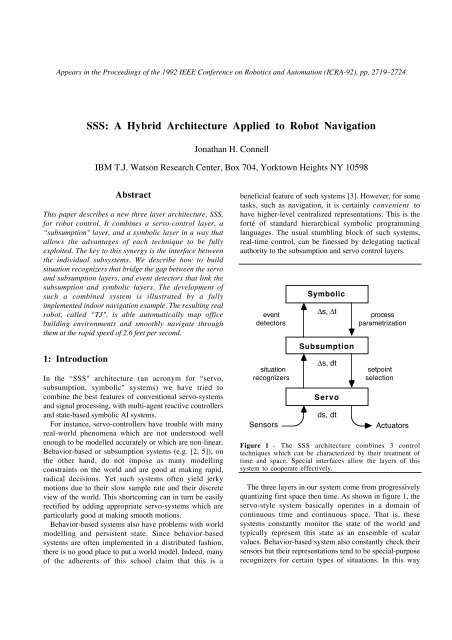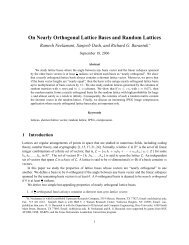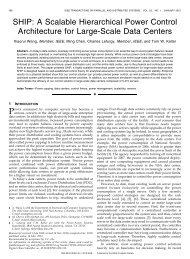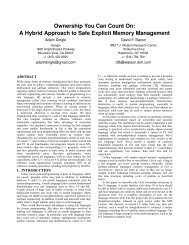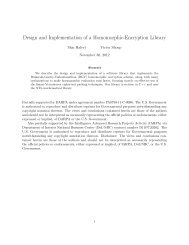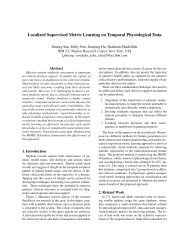SSS: A Hybrid Architecture Applied to Robot Navigation - CiteSeerX
SSS: A Hybrid Architecture Applied to Robot Navigation - CiteSeerX
SSS: A Hybrid Architecture Applied to Robot Navigation - CiteSeerX
You also want an ePaper? Increase the reach of your titles
YUMPU automatically turns print PDFs into web optimized ePapers that Google loves.
Appears in the Proceedings of the 1992 IEEE Conference on <strong>Robot</strong>ics and Au<strong>to</strong>mation (ICRA-92), pp. 2719Ð2724.<strong>SSS</strong>: A <strong>Hybrid</strong> <strong>Architecture</strong> <strong>Applied</strong> <strong>to</strong> <strong>Robot</strong> <strong>Navigation</strong>Jonathan H. ConnellIBM T.J. Watson Research Center, Box 704, York<strong>to</strong>wn Heights NY 10598AbstractThis paper describes a new three layer architecture, <strong>SSS</strong>,for robot control. It combines a servo-control layer, aÒsubsumption" layer, and a symbolic layer in a way thatallows the advantages of each technique <strong>to</strong> be fullyexploited. The key <strong>to</strong> this synergy is the interface betweenthe individual subsystems. We describe how <strong>to</strong> buildsituation recognizers that bridge the gap between the servoand subsumption layers, and event detec<strong>to</strong>rs that link thesubsumption and symbolic layers. The development ofsuch a combined system is illustrated by a fullyimplemented indoor navigation example. The resulting realrobot, called ÒTJ", is able au<strong>to</strong>matically map officebuilding environments and smoothly navigate throughthem at the rapid speed of 2.6 feet per second.1: IntroductionIn the Ò<strong>SSS</strong>" architecture (an acronym for Òservo,subsumption, symbolic" systems) we have tried <strong>to</strong>combine the best features of conventional servo-systemsand signal processing, with multi-agent reactive controllersand state-based symbolic AI systems.For instance, servo-controllers have trouble with manyreal-world phenomena which are not unders<strong>to</strong>od wellenough <strong>to</strong> be modelled accurately or which are non-linear.Behavior-based or subsumption systems (e.g. [2, 5]), onthe other hand, do not impose as many modellingconstraints on the world and are good at making rapid,radical decisions. Yet such systems often yield jerkymotions due <strong>to</strong> their slow sample rate and their discreteview of the world. This shortcoming can in turn be easilyrectified by adding appropriate servo-systems which areparticularly good at making smooth motions.Behavior-based systems also have problems with worldmodelling and persistent state. Since behavior-basedsystems are often implemented in a distributed fashion,there is no good place <strong>to</strong> put a world model. Indeed, manyof the adherents of this school claim that this is abeneficial feature of such systems [3]. However, for sometasks, such as navigation, it is certainly convenient <strong>to</strong>have higher-level centralized representations. This is thefortŽ of standard hierarchical symbolic programminglanguages. The usual stumbling block of such systems,real-time control, can be finessed by delegating tacticalauthority <strong>to</strong> the subsumption and servo control layers.eventdetec<strong>to</strong>rssituationrecognizersSensorsSymbolic∆s, ∆tSubsumption∆s, dtServods, dtprocessparametrizationsetpointselectionActua<strong>to</strong>rsFigure 1 - The <strong>SSS</strong> architecture combines 3 controltechniques which can be characterized by their treatment oftime and space. Special interfaces allow the layers of thissystem <strong>to</strong> cooperate effectively.The three layers in our system come from progressivelyquantizing first space then time. As shown in figure 1, theservo-style system basically operates in a domain ofcontinuous time and continuous space. That is, thesesystems constantly moni<strong>to</strong>r the state of the world andtypically represent this state as an ensemble of scalarvalues. Behavior-based system also constantly check theirsensors but their representations tend <strong>to</strong> be special-purposerecognizers for certain types of situations. In this way
ehavior-based systems discretize the possible states of theworld in<strong>to</strong> a small number of special task-dependentcategories. Symbolic systems take this one step further andalso discretize time on the basis of significant events. Theycommonly use terms such as Òafter X do Y" and ÒperformA until B happens". Since we create temporal events onthe basis of changes in spatial situations, it does not makesense for us <strong>to</strong> discretize time before space. For the samereason, we do not include a fourth layer in which space iscontinuous but time is discrete.In order <strong>to</strong> use these three fairly different technologies wemust design effective interfaces between them. The firstinterface is the command transformation between thebehavior-based layer and the underlying servos.Subsumption-style controllers typically act by adjustingthe setpoints of the servo-loops, such as the wheel speedcontroller, <strong>to</strong> one of a few values. All relevant PIDcalculations and trapezoidal profile generation are thenperformed transparently by the underlying servo system.The sensory interface from a signal-processing front-end<strong>to</strong> the subsumption controller is a little more involved. Aproductive way <strong>to</strong> view this interpretation process is in thecontext of Òmatched filters" [16, 6]. The idea here is that,for a particular task, certain classes of sensory states areequivalent since they call for the same mo<strong>to</strong>r response bythe robot. There are typically some key features that, forthe limited range of experiences the robot is likely <strong>to</strong>encounter, adequately discriminate the relevant situationsfrom all others. Such Òmatched filter" recognizers are themechanism by which spatial parsing occurs.The command interface between the symbolic andsubsumption layers consists of the ability <strong>to</strong> turn eachbehavior on or off selectively [7], and <strong>to</strong> parameterizecertain modules. These event-like commands are Òlatched"and continue <strong>to</strong> remain in effect without requiring constantrenewal by the symbolic system.The sensor interface between the behavior-based layer andthe symbolic layer is accomplished by a mechanism whichlooks for the first instant in which various situationrecognizers are all valid. For instance, when the robot hasnot yet reached its goal but notices that it has not beenable <strong>to</strong> make progress recently, this generates a Òpathblocked"event for the symbolic layer. To help decouplethe symbolic system from real-time demands we have addeda structure called the Òcontingency table". This table allowsthe symbolic system <strong>to</strong> pre-compile what actions <strong>to</strong> takewhen certain events occur, much as baseball outfieldersyell <strong>to</strong> each other Òthe play's <strong>to</strong> second" before a pitch. Theentries in this table reflect what the symbolic systemexpects <strong>to</strong> occur and each embodies a one-step plan forcoping with the actual outcome.Figure 2 - TJ has a 3-wheeled omni-directional base and usesboth sonar ranging and infrared proximity detection fornavigation. All servo-loops, subsumption modules, and thecontingency table are on-board. The robot receives pathsegment commands over a spread-spectrum radio link.2: The navigation taskThe task for our robot (shown in figure 2) is <strong>to</strong> map acollection of corridors and doorways and then rapidlynavigate from one office in the building <strong>to</strong> another. Toaccomplish this we had <strong>to</strong> address two basic navigationproblems. The first of these is compensating for thevariability of the environment. There are often people inthe halls, doors open and close by random amounts, somedays there are large stacks of boxes, and the trash cans arealways moving around.We solve the variability problem by restricting ourselves<strong>to</strong> very coarse geometric maps. We record only the distanceand orientations between relevant intersections. The actualdetails of the path between two points are never recorded,thus there are never any details <strong>to</strong> correct. However, <strong>to</strong>make use of such a coarse map the robot must be able <strong>to</strong>reliably follow the segments so described [4]. Fortunately,behavior-based systems are particularly good at this sort oflocal navigation.The other basic navigation problem is knowing whenthe robot has arrived back in a place it has been before. Thedifficulty is that, using standard robot sensory systems, anindividual office or particular intersection is notdistinguishable from any other. One approach is <strong>to</strong> useodometry <strong>to</strong> determine the absolute position of the robot.
However, it is well known that over long distances suchmeasurements can drift quite severely due <strong>to</strong> differingsurface traction and non-planar areas.We solve the loop problem by exploiting the geometryof the environment. In most office buildings all corridorsare more or less straight and meet at right angles. Thereforewe measure the length of each path segment and treat thisas a straight line. Similarly, when the robot switches fromone path <strong>to</strong> another we force the turn <strong>to</strong> be a multiple of90 degrees. This is essentially an odometric representationwhich is recalibrated in both heading and travel distance ateach intersection. In this way we maintain a coarse (x, y)position estimate of the robot which can be compared <strong>to</strong>the s<strong>to</strong>red coordinates of relevant places.2.1: Tactical navigationTactical, or moment-<strong>to</strong>-moment control of the robot ishandled by the servo and subsumption layers of ourarchitecture. The servo layer consists of two velocitycontrollers, one for translation and one for rotation, on therobot base. These proportional controllers operate at 256Hz and have acceleration-limited trapezoidal profiling.Built on <strong>to</strong>p of these servo-controllers are variousreactive behaviors which run at a rate of 7.5Hz. One of themore important of these is wall following. For this we usea carefully arranged set of side-looking infrared proximitydetec<strong>to</strong>rs. The method for deriving of specific responses foreach sensory state is detailed in [4, 6] for similar systems.While some researchers have tried <strong>to</strong> fuse sensory data overtime and then fit line segments of it, most Òwalls" that wewant <strong>to</strong> follow are not really flat. There are always gapscaused by doors, and often junk in the hall that makes thewalls look lumpy. This is the same reason we did not try<strong>to</strong> implement this activity as a servo-controller: it is veryhard <strong>to</strong> directly extract angle and offset distance from thetype of sensory information we have available. Thematched filter approach lets us get way with only partialrepresentations of the environment relative <strong>to</strong> the robot.There are also two tactical navigation modules based onodometry. The first of these looks at the cumulative traveland slows or s<strong>to</strong>ps the robot when the value gets close <strong>to</strong> aspecified distance. A similar setup exists based on theaverage heading of the robot. The average heading iscomputed by slowly shifting the old average heading value<strong>to</strong>ward the robot's current direction of travel. If the robot isonly turning in place the average heading does not change,but after the robot has travelled about 5 feet in a newdirection the value will be very close <strong>to</strong> the actual heading.A special behavior steers the robot <strong>to</strong> keep this Òtail"straight behind, which in turn causes the robot <strong>to</strong> remainaligned with its average heading. This is very useful forcorrecting the robot's direction of travel after it has veeredaround an obstacle. If the de<strong>to</strong>ur is short, the averageheading will not have been affected much.The average heading signal provides an interestingopportunity for the symbolic system <strong>to</strong> deliberately Òfakeout" the associated behaviors. For instance, the symbolicsystem can cleanly specify a new direction of travel for therobot by yanking around the robot's Òtail". This method isbetter than commanding the robot <strong>to</strong> follow a new absolutedirection, especially for cases in which the robot was notaligned precisely with the original corridor or in which thenew corridor seems <strong>to</strong> bend gradually (in actuality or fromodometric drift). Instead of forcing the robot <strong>to</strong> continuallyscrape its way along one wall or the other, the averageheading will eventually adjust itself <strong>to</strong> reflect the directionalong which progress has been made and thereby allow therobot <strong>to</strong> proceed smoothly.Although they sound like servo-controllers, the twoodometric behaviors were put in the subsumption layer fortwo reasons. First, they do not require fine-grained errorsignals. The alignment behavior is quiescent if the robot isÒclose" <strong>to</strong> the right heading, and the travel behavior onlyslows the robot when it is Ònear" the goal. Second, andmore importantly, we wanted these behaviors <strong>to</strong> interactwith other subsumption behaviors. For example, thealignment behavior takes precedence over the part of wallfollowing that moves the robot closer <strong>to</strong> a surface,however it is not as important as collision avoidance.Many of these other behaviors are necessarily cast in asubsumption style framework because of the limitedquality of sensory information available. Thus, <strong>to</strong>accommodate the appropriate dominance relations, thealignment and travel limiting behaviors were also includedin this layer.2.2: Strategic navigationThe strategic part of navigation Ð where <strong>to</strong> go next Ð ishandled by the symbolic layer. To provide thisinformation, our symbolic system maintains a coarsegeometric map of the robot's world. This map consists of anumber of landmarks, each with a type annotation, and anumber of paths between them, each with an associatedlength. The landmarks used in the map are the suddenappearance and disappearance of side walls. These aredetected by long range IR proximity detec<strong>to</strong>rs on each sideof the robot. Normally, in a corridor the robot wouldcontinuously perceive both walls. When it gets <strong>to</strong> anintersection, suddenly there will be no wall within range ofone or both of these sensors. Similarly, when the robot iscruising down a corridor and passes an office, the IR beamwill enter the room far enough so that no return is detected.
Once a map has been created, an efficient route can beplotted by a spreading activation algorithm [10] or someother method. To traverse this route, the symbolic systemenables whatever collection of subsumption modules itdeems appropriate for the first segment and parameterizestheir operation in appropriate ways. The symbolic systemdoes not need <strong>to</strong> constantly fiddle with the subsumptionlayer, it only has <strong>to</strong> reconfigure the layer when specificevents occur. In our navigation example, this typicallyhappens when the robot has reached the end of one pathsegment and needs <strong>to</strong> have its course altered <strong>to</strong> put it onthe next segment. In this case, the alteration ofsubsumption parameters must be swift or the robot willovershoot the intersection. To relieve this real-time burdenfrom the symbolic system we create a Òcontingency table"such as shown in figure 3 (in pseudo-LISP code). Thisstructure is similar <strong>to</strong> the Òevent dispatch" clauses in theoriginal subsumption architecture [2].(do-until-return(setq recognizers (check-situations))(cond ((and (near-distance? recognizers)(aligned-okay? recognizers)(left-opening? recognizers))(inc-heading! 90)(new-travel! 564)(return recognizers))((beyond-distance? recognizers)(inc-heading! 180)(new-travel! 48)(return recognizers))((no-progress? recognizers)(disable! stay-aligned)(enable! scan-for-escape)(return recognizers))(t nil)))Figure 3 - The Òcontingency table" continuously moni<strong>to</strong>rs acollection of special-purpose situation recognizers. When aspecified conjunction occurs, this Òevent" causes a new set ofpermissions and parameters <strong>to</strong> be passed <strong>to</strong> the subsumptionsystem. After this, the symbolic system builds a new table.The contingency table allows the symbolic system <strong>to</strong>specify a number of events and what response <strong>to</strong> make ineach case. As suggested by the code, this contingency tablemodule continually checks the status of a number ofspecial-purpose situation recognizers. When one of thelisted conjunctions occurs, the module performs thespecified alterations <strong>to</strong> the subsumption controller thenreturns the triggering condition <strong>to</strong> the symbolic system. Iftwo or more events occur simultaneously, the action forthe one listed first is taken. After this one burst of activitythe old contingency table is flushed and the symbolicsystem is free <strong>to</strong> load an entirely new table.For the navigation application, the contingency tableincludes a check for an opening in the correct direction atan appropriate path displacement, along with commands <strong>to</strong>reset the orientation and travel distances for the next pathsegment (see figure 3). Notice that the robot also checks <strong>to</strong>make sure it is aligned with the average heading when i<strong>to</strong>bserves an IR opening <strong>to</strong> the left. This is <strong>to</strong> keep therobot from mistakenly triggering the next subsumptionconfiguration just because the IR signal happened <strong>to</strong>vanish as the robot was veering around some obstacle inits path.3: Experimental resultsOur first experiment was aimed at validating the claim thatenvironmentally constrained odometry allows us <strong>to</strong> solvethe loop navigation problem. For this we provided therobot with a rough path <strong>to</strong> follow of the the form: ((travel1turn1) (travel2 turn2) ...). Travel was specified as anintegral number of inches and turns were specified as anintegral number of degrees. The <strong>to</strong>p half of figure 4 showsthe path the robot <strong>to</strong>ok according <strong>to</strong> its odometry. Thecircles with small projections indicate where the robo<strong>to</strong>bserved openings in the directions indicated. The circlesare the same size as the robot (12 inches diameter) <strong>to</strong>provide scale. Notice that neither of the loops appears <strong>to</strong> beclosed. Based on this information it is questionablewhether the corridor found in the middle of the map is thesame one which the robot later traversed.The symbolic map, which appears in the lower half offigure 4, correctly matches the important intersections <strong>to</strong>each other. In this map, nodes are offset slightly <strong>to</strong> the sideof the path segments. Each node's type is denotediconically as a corner Ð two short lines indicating thedirection of the opening and the direction of free travel.This symmetry reflects the fact that the robot is likely <strong>to</strong>perceive the same corner when coming out through themarked aperture. Corner nodes are placed at the robotposition where they are sensed; no adjustment is made forthe width of the corridor. This is partially compensated bya wide <strong>to</strong>lerance in matching nodes.When a new opening is detected the robot compares itwith all the other nodes in the map that have similaropening directions. If there is a match which is no morethan 6 feet from the robot's current position in either x ory, the new opening is considered <strong>to</strong> be a sighting of the oldnode. In this case we average the positions of the robot andthe node and move both <strong>to</strong> this new location. Thismerging operation is why the corridors do not look
perfectly straight in the symbolic map. However, when therobot is instructed <strong>to</strong> follow the same path a second timeand update the map, the changes are minimal.large displacements. However, the local details arequalitatively correct (some of the angularity is due <strong>to</strong> thetime lag between successive position readings). Ondifferent runs we started the robot in slightly differentdirections. We also altered the positions of variousobstacles along the path and changed the states of some ofthe doors on the corridor. This lead <strong>to</strong> slightly differentforms for each of the runs. Despite these variations ininitial heading and the configuration of the environment,the symbolic system was able <strong>to</strong> successfully navigate therobot <strong>to</strong> its goal in all 5 runs.Figure 5 - These traces illustrate the odometrically perceivedpath of the robot on 5 consecutive runs along the same path.Notice that the wiggles along each segment are different sinceobstacles were moved and doors were altered between runs. Tothe symbolic system, however, all runs seemed identical.Figure 4 - Geometric constraints of the environment allowthe robot <strong>to</strong> build maps with loops despite poor absoluteodometry. The <strong>to</strong>p picture shows the path the robot thought it<strong>to</strong>ok. The hair-like projections indicate openings it sensed.The lower picture shows the map the robot built during thisexploration.The second experiment shows that the subsumptionsystem is sufficiently competent at local navigation <strong>to</strong>allow the use of a coarse geometric map. In thisexperiment we had the symbolic system plan a path (fromnode 10 <strong>to</strong> node 5) using the map it generated in the firstpart. We then <strong>to</strong>ld it <strong>to</strong> configure the two lower layers ofthe architecture <strong>to</strong> follow this path. The result of fiveconsecutive runs is shown in figure 5. The displayed pathsare based on the robot's odometry and hence do notaccurately reflect the robot's true position in space over4: DiscussionThe <strong>SSS</strong> architecture is related <strong>to</strong> a number of recentprojects in robot control architectures. The greatest degreeof similarity is with the ATLANTIS system developed atJPL [11, 9]. In this system there is a subsumption-styleÒcontrol" layer, an operating system-like Òsequencing"layer, and a model-building Òdeliberative" layer. As in ournavigation scheme, this system delegates the task offollowing a particular path segment control <strong>to</strong> a behaviorbasedsystem while using a rough <strong>to</strong>pological map <strong>to</strong>specify the turns between segments. A mobile robotdeveloped at Bell labs [15] also uses this same taskdecomposition as does the AuRA system [1] fromUMASS Amherst.However, in ATLANTIS (and in RAPs [8], itsintellectual predecessor) each of the behaviors in the
subsumption controller is associated with some Ògoal" andcan report on its progress <strong>to</strong>ward achievement of thisobjective. A control system developed at Hughes [13] alsorequires a similar signalling of process Òfailures". Theproblem with this type of system is that detecting truefailures at such a low level can be difficult. In our system,external occurrences, not the internal state of somesubsidiary process, determine when the behavior-basedsystem is reconfigured.ATLANTIS also places much more emphasis on thesequencer layer than we do. In ATLANTIS the deliberativelayer essentially builds a partially ordered Òuniversal plan"[14] which it downloads <strong>to</strong> the sequencer layer forexecution. Similarly, one of the control systems used onHILARE [12] generates off-line a Òmission" plan which ispassed <strong>to</strong> a supervisor module that slowly doles out pieces<strong>to</strong> the Òsurveillance manager" for execution. In suchsystems, the symbolic system is completely out of thecontrol loop during the actual performance of the prescribedtask. This exclusion allows for only simple fixes <strong>to</strong> plansand makes it difficult <strong>to</strong> do things such as update thetraversability of some segment in the map. In contrast, thecontingency table in the <strong>SSS</strong> system only decouples thesymbolic system from the most rapid form of the decisionmaking Ð the symbolic system must still constantly replanthe strategy and moni<strong>to</strong>r the execution of each step.In summary, with our <strong>SSS</strong> system we have attempted <strong>to</strong>provide a recipe for constructing fast-response, goal-directedrobot control systems. We suggest combining a linearservo-like system, a reactive rule-like system, and adiscrete-time symbolic system in the same controller. Thisis not <strong>to</strong> say a good robot could not be built using just oneof these technologies exclusively. We simply believe thatcertain parts of the problem are most easily handled bydifferent technologies. To this end we have tried <strong>to</strong> explainthe types of interfaces between systems that we have found<strong>to</strong> be effective. To summarize, the upward sensory linksare based on the temporal concepts of situations andevents, while the downward command links are based onparameter adjustment and setpoint selection.The <strong>SSS</strong> architecture has been used for indoor navigationand proved quite satisfac<strong>to</strong>ry. Developing a robot whichmoves at an average speed of 32 inches per second (thepeak speed is higher), but which can still reliably navigate<strong>to</strong> a specified goal, is a non-trivial problem. It requiredusing a subsumption approach <strong>to</strong> competently swervearound obstacles, a symbolic map system <strong>to</strong> keep the robo<strong>to</strong>n track, and a number of servo controllers <strong>to</strong> make therobot move smoothly.We plan <strong>to</strong> extend this work <strong>to</strong> a number of differentnavigation problems including the traversal of openlobbies, movement within a particular room, and outdoorspatrol in a parking lot. We also intend <strong>to</strong> use a similarsystem <strong>to</strong> acquire and manipulate objects using a largermobile robot with an on-board arm.References[1] Ronald C. Arkin, ÒMo<strong>to</strong>r Schema Based <strong>Navigation</strong> fora Mobile <strong>Robot</strong>", Proceedings of the IEEE Conferenceon <strong>Robot</strong>ics and Au<strong>to</strong>mation, 264Ð271, 1987.[2] Rodney Brooks, ÒA Layered Intelligent Control Systemfor a Mobile <strong>Robot</strong>", IEEE Journal <strong>Robot</strong>ics andAu<strong>to</strong>mation, RA-2, 14-23, April 1986.[3] Rodney Brooks, ÒIntelligence withoutRepresentation", Artificial Intelligence, vol. 47, 139Ð160, 1991.[4] Jonathan H. Connell, Ò<strong>Navigation</strong> by PathRemembering", Proceedings of the 1988 SPIEConference on Mobile <strong>Robot</strong>s, 383Ð390.[5] Jonathan H. Connell, Minimalist Mobile <strong>Robot</strong>ics: AColony-style <strong>Architecture</strong> for a Mobile <strong>Robot</strong>,Academic Press, Cambridge MA, 1990 (also MIT TR-1151).[6] Jonathan H. Connell, ÒControlling a <strong>Robot</strong> UsingPartial Representations", Proceedings of the 1991 SPIEConference on Mobile <strong>Robot</strong>s, (<strong>to</strong> appear).[7] Jonathan H. Connell and Paul Viola, ÒCooperativeControl of a Semi-au<strong>to</strong>nomous Mobile <strong>Robot</strong>",Proceedings of the IEEE Conference on <strong>Robot</strong>ics andAu<strong>to</strong>mation, Cincinnati OH, 1118Ð1121, May 1990.[8] R. James Firby, ÒAn Investigation in<strong>to</strong> ReactivePlanning in Complex Domains", Proceedings of AAAI-87, 202Ð206, 1987.[9] Erann Gat, ÒTaking the Second Left: Reliable Goal-Directed Reactive Control for Real-world Au<strong>to</strong>nomousMobile <strong>Robot</strong>s", Ph.D. thesis, Virginia PolytechnicInstitute and State University, May 1991.[10] Maja J. Mataric, ÒEnvironment Learning Using aDistributed Representation", Proceedings of the IEEEConference on <strong>Robot</strong>ics and Au<strong>to</strong>mation, 402Ð406,1990.[11] David P. Miller and Erann Gat, ÒExploiting KnownTopologies <strong>to</strong> Navigate with Low-ComputationSensing", Proceedings of the 1991 SPIE Conference onSensor Fusion, 1990.[12] Fabrice R. Noreils and Raja G. Chatila, ÒControl ofMobile <strong>Robot</strong> Actions", Proceedings of the IEEEConference on <strong>Robot</strong>ics and Au<strong>to</strong>mation, 701Ð707,1989.[13] David W. Pay<strong>to</strong>n, ÒAn <strong>Architecture</strong> for ReflexiveAu<strong>to</strong>nomous Vehicle Control", Proceedings of the IEEEConference on <strong>Robot</strong>ics and Au<strong>to</strong>mation, 1838Ð1845,1986.[14] Marcel Schoppers, ÒUniversal Plans for Reactive<strong>Robot</strong>s in Unpredictable Environments", Proceedingsof IJCAI-87, Milan Italy, 1039Ð1046, August 1987.[15] Monnett Hanvey Soldo, ÒReactive and PreplannedControl in a Mobile <strong>Robot</strong>", Proceedings of the IEEEConference on <strong>Robot</strong>ics and Au<strong>to</strong>mation, CincinnatiOH, 1128Ð1132, May 1990.[16] RŸdiger Wehner, ÒMatched Filters - Neural Models ofthe External World", Journal of ComparativePhysiology, 161:511-531.


